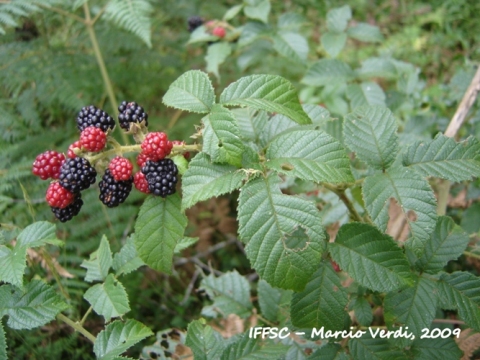Rubus brasiliensis
Mart.
Rosaceae
The genus Rubus, (especially the blackberries, which are often loosely referred to as Rubus fruticosus agg.) presents some of the most difficult taxonomic problems. This is partly due to the frequency of polyploidy; also to the frequent occurrence of hybridization; and also due to apomixis, where minor differences between plants are preserved because seedlings are genetically identical to their parent. As a result, differences of opinion on the number of species to be recognized from a given region can vary tremendously (for example, a treatment by M. L. Fernald[
43- Title
- Gray's Manual of Botany.Eighth Edition
- Publication
-
- Author
- Fernald. M. L.
- Publisher
- American Book Co.; New York
- Year
- 1950
- ISBN
- 0442222505
- Description
- A bit dated but a good and concise flora of the eastern part of N. America.
] in 1950 recognized 205 species for the northern half of the eastern United States plus parts of southeastern Canada, whilst H. A. Gleason and A. Cronquist in 1991 recognized only 25)[
270- Title
- Flora of N. America
- Publication
-
- Author
-
- Website
- http://flora.huh.harvard.edu/fna/
- Publisher
-
- Year
- 0
- ISBN
-
- Description
- An on-line version of the flora with an excellent description of the plant including a brief mention of plant uses.
]. Where possible, a relatively conservative approach is taken here[
K- Title
- Plants for a Future
- Author
- Ken Fern
- Description
- Notes from observations, tasting etc at Plants For A Future and on field trips.
].
Common Name: Amorinha Verde
General Information
Rubus brasiliensis is a spiny shrub growing 1 - 2 metres tall.
The edible fruits are gathered from the wild and consumed locally. The plant is sometimes cultivated for its fruits. An ornamental plant, it is valued particularly for its flowers[
,
].
Known Hazards
None known
Botanical References
Range
S. America - Argentina, Brazil.
Habitat
Common on he edges of forests and in open places[
].
Properties
| Edibility Rating |      |
| Medicinal Rating |      |
| Other Uses Rating |      |
| Habit | Shrub |
| Height | 1.50 m |
| Cultivation Status | Cultivated, Ornamental, Wild |
Cultivation Details
A plant of moderate elevations in the subtropics to tropics, being found at elevations from 700 - 1,600 metres in the tropics.
Requires a position in full sun or bright shade[
]. Succeeds in most soils[
].
Edible Uses
Fruit - raw or made into drinks, jellies etc[
46- Title
- Dictionary of Economic Plants.
- Publication
-
- Author
- Uphof. J. C. Th.
- Publisher
- Weinheim
- Year
- 1959
- ISBN
- -
- Description
- An excellent and very comprehensive guide but it only gives very short descriptions of the uses without any details of how to utilize the plants. Not for the casual reader.
,
]. A pleasant, sweet flavour[
].
Medicinal
The plant is used in folk medicine[
].
The aerial parts of the plant are used in the treatment of nervous breakdowns[
1166- Title
- Therapeutic Constituents and Actions of Rubus Species
- Publication
- Current Medicinal Chemistry Vol 11 Issue 11 2004
- Author
- Patel A.V.; Rojas-Vera J.; Dacke C.G.
- Publisher
-
- Year
- 2004
- ISBN
-
- Description
- A summary of the various medicinal uses of the genus Rubus
]. Both hexane and ethane extracts of the leaves have been shown to have an anxiolytic effect similar to benzodiazepine drugs[
1166- Title
- Therapeutic Constituents and Actions of Rubus Species
- Publication
- Current Medicinal Chemistry Vol 11 Issue 11 2004
- Author
- Patel A.V.; Rojas-Vera J.; Dacke C.G.
- Publisher
-
- Year
- 2004
- ISBN
-
- Description
- A summary of the various medicinal uses of the genus Rubus
].
Agroforestry Uses:
A pioneer species, readily invading pastures[
].
Other Uses
None known
Propagation
Seed - germinates best if given a period of cold stratification prior to sowing in containers. Stored seed requires one month stratification at about 3°c and is best sown as early as possible in the growing season. Prick out the seedlings when they are large enough to handle and grow on until large enough to plant out.
Cuttings of half-ripe wood in a frame[
200- Title
- The New RHS Dictionary of Gardening. 1992.
- Publication
-
- Author
- Huxley. A.
- Publisher
- MacMillan Press
- Year
- 1992
- ISBN
- 0-333-47494-5
- Description
- Excellent and very comprehensive, though it contains a number of silly mistakes. Readable yet also very detailed.
].
Tip layering towards the end of the growing season
Division just before the plant comes into new growth or as it enters dormancy[
200- Title
- The New RHS Dictionary of Gardening. 1992.
- Publication
-
- Author
- Huxley. A.
- Publisher
- MacMillan Press
- Year
- 1992
- ISBN
- 0-333-47494-5
- Description
- Excellent and very comprehensive, though it contains a number of silly mistakes. Readable yet also very detailed.
].
If you have any useful information about this plant, please leave a comment. Comments have to be approved before they are shown here.







 Useful Tropical Plants Database 2014 by
Ken Fern,
web interface by
Ajna Fern
with help from
Richard Morris.
Useful Tropical Plants Database 2014 by
Ken Fern,
web interface by
Ajna Fern
with help from
Richard Morris.